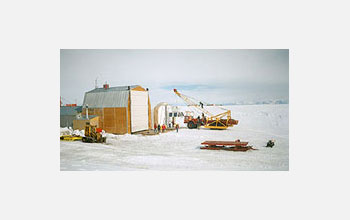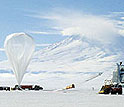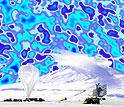|

Fact Sheet
Balloon-based Astronomy in Antarctica

May 10, 2002
Background
The National Science Foundation (NSF), through its Office of Polar Programs, supports long-duration balloon (LDB) flights in Antarctica to conduct astrophysical experiments. Circling the continent on unique stratospheric winds at altitudes of roughly 37 kilometers (22.9 miles) for periods of up to 31 days, experiments operate in an area that is almost free of atmospheric interference. For some experiments, this provides scientists with conditions equivalent to flight aboard a satellite or the space shuttle, at much lower cost.
Unique conditions
Two unique geophysical conditions above Antarctica make long-duration balloon flights that circumnavigate the continent possible during the austral summer:
- First, a nearly circular pattern of gentle east-to-west winds establishes itself in the Antarctic stratosphere lasting for a few weeks. The circulation is generated by a long-lived high-pressure area caused by the constant solar heating of the stratosphere. This allows the launching and recovery of a balloon from roughly the same geographic location and permits a flight path that is almost entirely over land.
- Second, because the sun never sets during the austral summer, the balloon is illuminated continuously, both directly and by reflection from the underlying clouds or snow. As a result, the balloon maintains a constant temperature and is able to maintain a stable altitude. In other areas of the world, the daily heating and cooling cycles change the volume of gas in the balloon, causing it to rise and fall and expend ballast, severely limiting flight times.
As an international zone under the Antarctic Treaty, balloons can be launched, flown and recovered anywhere on the continent without diplomatic complications experienced in other areas of the globe.
History
Since 1988, NSF and NASA have developed techniques for flying and recovering large balloon payloads -- in the range of two tons -- at altitudes of roughly 37 kilometers (22.9 miles) for extended periods.
Over the past decade there have been LDB flights in most Antarctic research seasons -- roughly mid-December through mid-January -- frequently with two balloons being flown during the season.
During the 2001-2002 Antarctic research season, the balloon-borne Trans-Iron Galactic Element Recorder (TIGER) experiment, designed to search for the origin of cosmic rays, achieved a flight-duration record over Antarctica. Launched at 6:30 a.m. EST on Dec. 20, 2001, the balloon traveled approximately 1,400 kilometers (869 miles) before landing, 31 days, 20 hours later, at 3:03 a.m. EST, Jan. 21, 458 kilometers (284 miles) from McMurdo Station, NSF's logistical hub in Antarctica.
For more information about TIGER, see: http://cosray2.wustl.edu/tiger/
For more information about the TIGER flight path from NASA, see: http://192.149.107.13/ldb/balloona.jpg
In 1998, the Balloon Observations of Millimetric Extragalactic Radiation and Geophysics (BOOMERANG) experiment obtained the first detailed images of the universe in its infancy. The images revealed the structure that existed in the universe when it was a tiny fraction of its current age and 1,000 times smaller and hotter than it is today.
For more information about BOOMERANG, see: http://www.nsf.gov/od/lpa/news/press/00/pr0025.htm
Logistics of Antarctic ballooning
NASA operates the National Scientific Balloon Facility in Palestine, Texas, which supports balloon flights worldwide. Antarctic experiment packages are prepared at the NSBF, but must be sent to McMurdo Station via NSF's cargo facilities in Port Hueneme, Calif. through Christchurch, New Zealand.
Flight operations are conducted from Williams Field, near McMurdo Station, which provides complete logistical support, including transportation, housing, supplies and heavy equipment to balloon teams.
The Antarctic research season runs from October through February. However, regional weather does not normally stabilize until early December. Because recovery aircraft are more in demand near the end of the season, the Antarctic balloon launch window lasts only about six weeks. By early February, icebreakers have created a channel through the sea ice that that rings the continent to allow a supply ship to bring in heavy equipment for the next season. This cargo often includes truckloads of helium for the following year's balloon flights.
-NSF-
For more BOOMERANG images, including high-resolution images, see http://cmb.phys.cwru.edu/boomerang/pictures.html

Media Contacts
Peter West, NSF (703) 292-8070 pwest@nsf.gov

The National Science Foundation (NSF) is an independent federal agency that
supports fundamental research and education across all fields of science and
engineering, with an annual budget of $6.06 billion. NSF funds reach all 50
states through grants to over 1,900 universities and institutions. Each year,
NSF receives about 45,000 competitive requests for funding, and makes over
11,500 new funding awards. NSF also awards over $400 million in
professional and service contracts yearly.
 Get News Updates by Email Get News Updates by Email
Useful NSF Web Sites:
NSF Home Page: http://www.nsf.gov
NSF News: http://www.nsf.gov/news/
For the News Media: http://www.nsf.gov/news/newsroom.jsp
Science and Engineering Statistics: http://www.nsf.gov/statistics/
Awards Searches: http://www.nsf.gov/awardsearch/
| 






